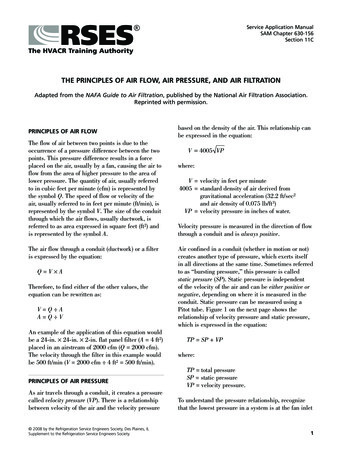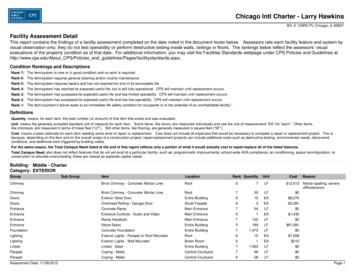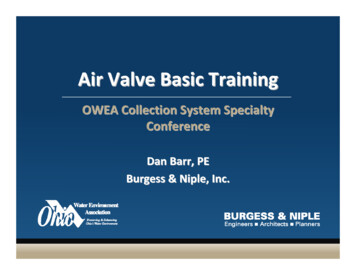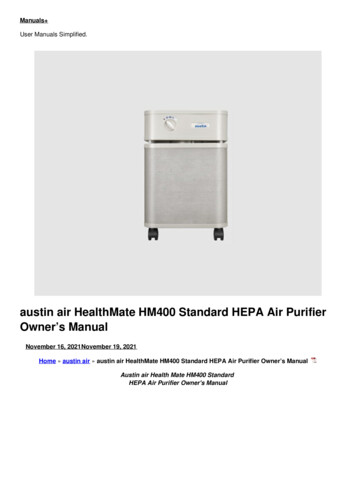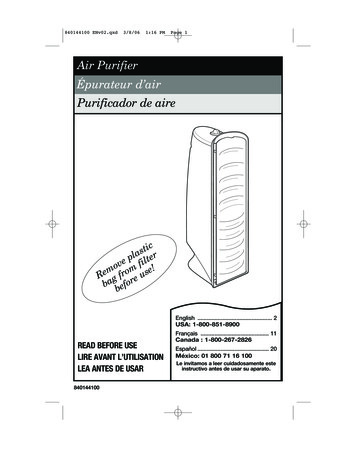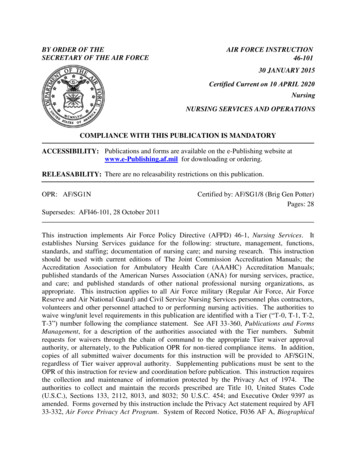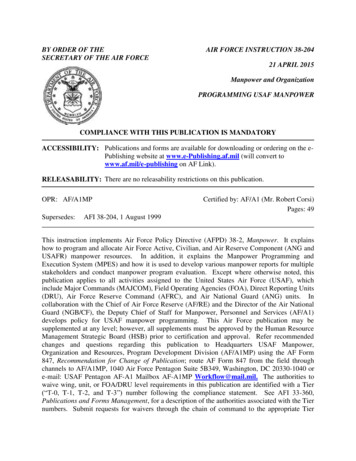
Transcription
BY ORDER OF THESECRETARY OF THE AIR FORCEAIR FORCE INSTRUCTION 38-20421 APRIL 2015Manpower and OrganizationPROGRAMMING USAF MANPOWERCOMPLIANCE WITH THIS PUBLICATION IS MANDATORYACCESSIBILITY: Publications and forms are available for downloading or ordering on the ePublishing website at www.e-Publishing.af.mil (will convert towww.af.mil/e-publishing on AF Link).RELEASABILITY: There are no releasability restrictions on this publication.OPR: AF/A1MPSupersedes:Certified by: AF/A1 (Mr. Robert Corsi)Pages: 49AFI 38-204, 1 August 1999This instruction implements Air Force Policy Directive (AFPD) 38-2, Manpower. It explainshow to program and allocate Air Force Active, Civilian, and Air Reserve Component (ANG andUSAFR) manpower resources. In addition, it explains the Manpower Programming andExecution System (MPES) and how it is used to develop various manpower reports for multiplestakeholders and conduct manpower program evaluation. Except where otherwise noted, thispublication applies to all activities assigned to the United States Air Force (USAF), whichinclude Major Commands (MAJCOM), Field Operating Agencies (FOA), Direct Reporting Units(DRU), Air Force Reserve Command (AFRC), and Air National Guard (ANG) units. Incollaboration with the Chief of Air Force Reserve (AF/RE) and the Director of the Air NationalGuard (NGB/CF), the Deputy Chief of Staff for Manpower, Personnel and Services (AF/A1)develops policy for USAF manpower programming. This Air Force publication may besupplemented at any level; however, all supplements must be approved by the Human ResourceManagement Strategic Board (HSB) prior to certification and approval. Refer recommendedchanges and questions regarding this publication to Headquarters USAF Manpower,Organization and Resources, Program Development Division (AF/A1MP) using the AF Form847, Recommendation for Change of Publication; route AF Form 847 from the field throughchannels to AF/A1MP, 1040 Air Force Pentagon Suite 5B349, Washington, DC 20330-1040 ore-mail: USAF Pentagon AF-A1 Mailbox AF-A1MP Workflow@mail.mil. The authorities towaive wing, unit, or FOA/DRU level requirements in this publication are identified with a Tier(“T-0, T-1, T-2, and T-3”) number following the compliance statement. See AFI 33-360,Publications and Forms Management, for a description of the authorities associated with the Tiernumbers. Submit requests for waivers through the chain of command to the appropriate Tier
2AFI38-204 21 APRIL 2015waiver approval authority, or alternately, to the Publication OPR for non-tiered complianceitems. Ensure that all records created as a result of processes prescribed in this publication aremaintained in accordance with Air Force Manual (AFMAN) 33-363, Management of Records,and disposed of in accordance with Air Force Records Disposition Schedule (RDS) in the AirForce Information Management System (AFRIMS). The use of a name or mark of any specificmanufacturer, commercial product, commodity, or service in this publication does not implyendorsement by the Air Force.SUMMARY OF CHANGESThis publication has been substantially revised and must be completely reviewed. Majorchanges include expansion of manpower programming information contained in 1 Aug 1999version of AFI 38-204, realignment of some information to AFI 38-201, Management ofManpower Requirements and Authorizations, transfer of information formerly contained in therescinded 1 Mar 1995 version AFI 38-202, Air Force Management Headquarters andHeadquarters Support Activities, new organizational references, addition of base support factors,identification of manpower data system changes, and Tier Waiver Authorities as outlined in AFI33-363, Publications and Forms Management, paragraph 1.9Chapter 1—GENERAL INFORMATION51.1.Overview. .51.2.Guiding Principles. .51.3.Events. .51.4.Roles and Responsibilities. .6Chapter 2—DEFINING AND MANAGING AIR FORCE END STRENGTH82.1.Manpower Resource Accountability. .82.2.General Guidance. .8Chapter 3—PROGRAMMING TOOLS103.1.Estimating Manpower Requirements. .103.2.Weapon System Zero Base (ZB) Procedures. .103.3.Base Support Tail (BST) Factors. .123.4.Management Headquarters (MHQ) Factors. .123.5.Individuals Account Manpower Programming Tools. .13Chapter 4—ADJUSTING END STRENGTH144.1.AFCS Change Control Number (CCN). .144.2.Manpower Zero Balance Transfer (ZBT). .144.3.Out of Cycle End Strength Changes. .15
AFI38-204 21 APRIL 2015Chapter 5—ADJUSTING END STRENGTH- SPECIAL CONSIDERATIONS3175.1.Overview. .175.2.Overseas Ceilings/Floors. .175.2.The Executive Agent Roles and Responsibilities: .175.3.Major DoD Headquarters Activities. .185.4.Joint Manpower. .185.5.Special Access Programs (SAP). .185.6.Defense Health Programs. .185.7.Special Operations Forces (SOF). .185.8.Intelligence. .185.9.Foreign Military Sales (FMS). .18Chapter 6—MANPOWER ALLOCATION AND UMD EXECUTION196.1.Overview. .196.2.General Guidance. .196.3.Roles and Responsibilities .196.4.MAJCOM UMD Management. .20Chapter 7—MANPOWER DATA SYSTEMS, REPORTING, AND PROGRAMEVALUATION217.1.Overview. .217.2.AF/A1MP Roles and Responsibilities - Budget Development andOSD/Congressional Reporting. .21AF/A1MP Roles and Responsibilities – MAJCOM and Equivalent ManpowerProgramming. .227.4.AF/A1MP Roles and Responsibilities - Joint Manpower Programming. .227.5.AF/A1MP Roles and Responsibilities – Manpower Program Evaluation. .22Chapter 8—INDIVIDUALS ACCOUNT - STUDENTS, TRANSIENTS AND PERSONNELHOLDEES (STP) PROGRAM247.3.8. 1.Overview. .248.2.Roles and Responsibilities. .248.3.STP (Individuals) Account Categories. .25Attachment 1—GLOSSARY OF REFERENCES AND SUPPORTING INFORMATION27Attachment 2—PPBE SYSTEMS AND TOOLS32Attachment 3—MANPOWER PROGRAMMING AND EXECUTION SYSTEM (MPES)34
4AFI38-204 21 APRIL 2015Attachment 4—ATTRIBUTES OF A PROGRAM ELEMENT36Attachment 5—AIR FORCE MANPOWER RESOURCE IDENTIFICATION CODES39Attachment 6—WEAPON SYSTEM ZERO BASE TEMPLATE41Attachment 7—BASE SUPPORT TAIL (BST) FACTORS46Attachment 8—OVER/UNDER EXECUTION REQUEST EXAMPLE48Attachment 9—MANAGEMENT HEADQUARTERS FACTORS49
AFI38-204 21 APRIL 20155Chapter 1GENERAL INFORMATION1.1. Overview. Air Force manpower is a critical resource. Manpower must be properlyidentified and resources allocated to ensure the Air Force has the capability to achieve itspeacetime and wartime missions. To support national security objectives, Air Force units mustsuccessfully accomplish missions using the optimal level of manpower that includes Active,Civilian, Air Reserve Component (ANG and USAFR) manpower resources and work that can becompleted by private-sector contractor support. The programming process is how the Air Forceensures commanders have the manpower resources to accomplish their assigned missions.1.2. Guiding Principles. Manpower guiding principles for requirements and programming arehighlighted in DoDD 1100.4, “Guidance for Manpower Management,” DoD 1100.22 “Policiesand Procedures for Workforce Mix,” AFPD 38-2 “Manpower,” AFI 38-201, “Management ofManpower Requirements and Authorizations,” and provides guidance which must be consideredwhen evaluating and executing programming decisions and activities.1.2.1. Manpower is a constrained resource that comprises a large portion of the Air ForceBudget. All missions and programs compete for limited authorized military and civilian endstrength, established grade distributions, and must comply with other guidelines as directedby Congress.1.2.2. Manpower resources must be programmed and allocated in a manner that contributesto the accomplishment of Air Force missions in priority order, and commensurate withavailable resources. Changes to programs, missions, capabilities and/or functions will dictatechanges to manpower resources. Private-sector contract support programming is notaddressed in this AFI and should be managed in accordance with the FAR and applicableSAF/AQ guidance.1.2.3. Manpower must be programmed in accordance with validated manpowerrequirements, and within fiscal limits and acceptable risk identified in Defense PlanningGuidance (DPG).1.2.4. Military manpower and appropriated civilian resources will be allocated to approvedprograms by Program Element (PE) consistent with budget submissions and Congressionaldirection. Manpower will not exceed approved levels, violate guidelines established byCongress, or violate other statutory limitations. The civilian workforce shall be managed onthe basis of workload and fiscal year funding except where imposed by Congress. SeeChapter 2 for additional information.1.3. Events. Manpower is programmed in conjunction with the Air Force Planning,Programming, Budgeting and Execution (PPBE) process as outlined in AFPD 16-5 Planning,Programming, Budgeting and Execution System and AFI 16-501 Control and Documentation ofAir Force Programs. Programmed manpower adjustments typically occur during four majorexercises within the PPBE process; 1) Baseline Extension, 2) Program ObjectiveMemorandum (POM), 3) Program and Budget Review (PBR), and 4) President’s Budget(PB).
6AFI38-204 21 APRIL 20151.3.1. The Baseline Extension occurs after the President’s Budget is signed and marks thebeginning of a new programmatic cycle. It unlocks a new programmatic year in theprogramming database.1.3.2. Services submit a POM annually to Office of the Secretary of Defense (OSD) toframe their program proposals and associated changes to the Future Years Defense Program(FYDP). The POM includes an analysis of missions, objectives, alternative methods toaccomplish objectives, and allocation of resources.1.3.3. The PBR enables OSD, Chairman Joint Chiefs of Staff (CJCS), CombatantCommanders (COCOMs), and Joint Staff to assess the Air Force submission for compliancewith the DPPG and other strategic guidance. OSD issues Resource Management Decisions(RMDs) to the services to make programmatic changes or corrections as a result of the PBR.1.3.4. The Service submissions, as modified by OSD RMD decisions, become theDepartment of Defense (DoD) submissions to the PB. The Office of Management andBudget (OMB) incorporates all budget submissions from all executive branches andconsolidates them into the PB submission to Congress. The PB is presented to Congressannually no later than the first Tuesday in February.1.3.5. A description of PPBE systems and tools is provided at Attachment 2.1.4. Roles and Responsibilities.1.4.1. MAJCOMs/DRUs/FOAs (NOTE: Through the remainder of this publication, theterm “MAJCOM and equivalents” will be used to generally refer to entities at theorganizational level represented by MAJCOMs, DRUs, and FOAs), Core Function Lead(CFL), Headquarters Air Force (HAF) Mission Panels and Program Element Monitors(PEM) generate, prioritize, and advocate for their respective manpower initiatives, offsets,and disconnects during a PPBE exercise.1.4.2. AF/A1M and AF/A1MP Roles and Responsibilities:1.4.2.1. AF/A1M facilitates all end strength adjustments made during a PPBE cycle orevent while serving as an advisor to the Air Force Corporate Structure (AFCS).1.4.2.2. AF/A1MP compiles, records, allocates and administers the AF’s “top-line” endstrength changes IAW fiscal year AFCS PPBE decisions. This end strength includesStudent, Trainee, and Personnel Hold (STP) accounts (i.e., Individuals accounts) and theAir Force portion of joint defense level activities and accounts centrally managed byOSD and ODNI (see special considerations outlined in Chapter 5). AF/A1MP willadvocate for manpower resources in support of the Individuals (non-unit) account. (SeeChapter 8).1.4.2.3. AF/A1MP assists the MAJCOMs, CFLs, HAF Mission Panels, and PEMs indevelopment of manpower change proposals and records approved changes in MPES.(See Attachment 3 for a description of MPES).1.4.2.4. AF/A1MP will ensure Total Force (TF) manpower adjustments are coordinatedand validated by the respective component OPR; namely AF/REXX (for Reservemanpower issues) and NGB/A1MP (for National Guard manpower issues).
AFI38-204 21 APRIL 201571.4.2.5. AF/A1MP will coordinate manpower options affecting the acquisition workforcewith SAF/AQH and SAF/AQX.1.4.2.6. AF/A1MP will co-chair manpower realignment working groups with AF/A8XIduring the POM to address the sourcing and redistribution of manpower resources duringAFCS deliberations and will facilitate sourcing of newly developed standards.1.4.2.7. AF/A1MP is responsible for providing personnel strength for Major DoDHeadquarter Activities in the AF FYDP and fiscal year budget exhibit submissions.1.4.3. AF/A1MR, MAJCOM/A1Ms, AFPC/MA and Manpower Requirement Squadrons(MRS) will assist with the validation of manpower requirement changes, as it relates to thequantification of offsets, disconnects, and initiatives, as needed. AF/A1M, in conjunctionwith SAF/OS(M), is the final approval authority for all manpower standards. Allrequirements resulting from their application are considered valid. (T-1).
8AFI38-204 21 APRIL 2015Chapter 2DEFINING AND MANAGING AIR FORCE END STRENGTH2.1. Manpower Resource Accountability. The DoD uses program elements in the FYDP tobudget for and control its resources. An Air Force Program Element Code (PEC) accounts forresources, to include end strength, needed to provide a specific capability. See Attachment 4 fora description of PEC attributes.2.1.1. Manpower Resource Identification Code (RIC). An Air Force PEC may contain threemanpower categories: officer, enlisted, and civilian for each component of the TF. A list ofcommonly used RICs is at Attachment 5.2.1.1.1. Reserve and ANG end strength is further identified in the FYDP by RIC as DrillOfficer, Drill Enlisted, and Active Guard and Reserve (AGR) Officer and Enlisted. AirForce Reserve (AFR) also has Individual Mobilization Augmentee (IMA) Officer andEnlisted.2.1.1.2. The Civilian category contains three subcategories: US Direct Hire (USDH),Foreign National Direct Hire (FNDH), and Foreign National Indirect Hire (FNIH).Memo entries are used to denote Guard and Reserve Technicians that are a subset of theUSDH category.2.2. General Guidance.2.2.1. Military active duty end strength levels are established by Congress. As such, endstrength must be managed within congressional limits. During AFCS deliberations,manpower programming will adhere to OSD Fiscal Guidance and HAF Quadrennial DefenseReview (QDR)/Annual Planning and Programming Guidance (APPG) direction.2.2.2. Civilian end strength, is not limited by congressional restraints and will be managedsolely on the basis of workload and fiscal year funding. Civilian end strength is not normallysubject to any other constraints or limits in terms of man-years, full-time equivalents orceilings unless specified by Congress.2.2.2.1. Guard and Reserve Technicians are exempt from any requirement (imposed bylaw or otherwise) for reductions in DoD civilian personnel and shall only be reduced aspart of military force structure reductions.2.2.2.2. Dollars (i.e., civilian pay) associated with reducing civilian end strength may beused during AFCS deliberations to offset bills in other areas, although caution should beused with AFRC/ANG civilian changes due to limits described above in paragraph2.2.2.1.2.2.3. MAJCOMs and equivalents may make changes to reimbursable positions if agreedto by the functional OPR and SAF/FMBOP; however, MAJCOMs and equivalents cannotretain savings generated by these changes and cannot create costs for the Air Force. (T-1).2.2.4. End strength in PECs controlled by agencies and activities outside of the Air Force(e.g., DHP, NIP, joint agencies) cannot be changed unless OSD has approved a writtenagreement (e.g. Memo of Agreement) between the AF and the affected activity or directed inPBR decision document.
AFI38-204 21 APRIL 201592.2.5. End-strength will not be programmed to accommodate cyclical or temporaryrequirements. Instead MAJCOMs and equivalents should use other means to accomplishtheir short term missions or surge workloads: (T-1).2.2.5.1. Use available funds and command civilian employment plans to employcivilians.2.2.5.2. Utilize overtime, temporary full-time, part-time, or over-hire of civilianpersonnel.2.2.5.3. Seek support from the AFRC/ANG via Military Pay Appropriation (MPA)funds.2.2.5.4. Utilize temporary duty military and civilian personnel.2.2.5.5. Seek contract services.
10AFI38-204 21 APRIL 2015Chapter 3PROGRAMMING TOOLS3.1. Estimating Manpower Requirements. When available, manpower estimates will bebased on approved crew ratios, LCOMs, AF manpower standards, Analysis of Alternatives(AoA), command guides or weapon system typical tools. For new and emerging missions,functional managers and manpower requirement experts will develop a manpower estimate.3.2. Weapon System Zero Base (ZB) Procedures. A Weapon System ZB is designed tooptimize allocation of operations and maintenance manpower end strength; first within aMAJCOM mission set and secondly across the AF FYDP. Weapon System ZBs matchauthorized/fielded weapons in conjunction with annual budget cycles and produce a weaponsystem typical as a programming tool to estimate manpower impacts against proposed forcestructure changes. A Weapon System ZB identifies all fixed (open-the-door costs) and variablecosts (requirements as outlined in a typical) tied to a weapon system program element. WeaponSystem ZBs do not take the place of Program Change Requests (PCRs) or funding of newrequirements.3.2.1. General Guidance.3.2.1.1. Use the appropriate weapon system force structure contained in approved forcetabs to populate the Primary Aircraft Inventory (PAI) for each location and Fiscal Year.PAI does not include Backup Aircraft Inventory (BAI) or Attrition Reserve Aircraft(AR); reference AFI 16-402 attachment 3, Aerospace Vehicle Inventory Relationships forfurther details.3.2.1.2. Use the most recent PB FYDP baseline to populate a weapons system ZB foreach system within the MAJCOM.3.2.1.3. Be aware that the combination of location, fiscal year timeline, and PAI numbersresult in a classified (SECRET) report.3.2.1.4. AF/A1MP will identify all current funded LCOMs, Force Tabs, and/or otherapproved tools and methods to be utilized during the Weapon System ZB process.3.2.1.5. Use only approved Crew Ratio (CR) and Crew Composition (CC) stated in AFI65-503, Table A36-1 or approved but not yet incorporated into AFI 65-503, US Air ForceCost and Planning Factors Table A36-1. CR and CC do not apply to Flying Trainingrequirements.3.2.1.6. When validating Weapon System Security (WSS) requirements and multipleweapon systems are parked in a single secure parking area, the primary (predominant)weapon system pays for the WSS. If there are additional parking areas required for otheraircraft, those aircrafts’ PEs will pay for the additional WSS.3.2.1.7. When determining Wing overhead requirements, use the primary weapon systemprogram element to account for the basic requirements (See Attachment 6). If more thanone weapon system exists at a location, the incremental overhead costs will be includedin the secondary weapon system ZB requirements.3.2.2. Process.
AFI38-204 21 APRIL 2015113.2.2.1. Fill in the established requirements for each location using a separate WeaponSystem ZB template for each mission design series (A-10, C-130, C-17, F-16, F-15C/D,F-15E, etc.).3.2.2.2. Calculate crew requirements per squadron.3.2.2.2.1. Begin with the PAI for the specific squadron and multiply by the approvedCR.3.2.2.2.2. If a fractional number, round up to get a whole number of crews for thesquadron.3.2.2.2.3. Multiply the number of crews by each crew position type.CREW REQUIREMENT CALCULATION EXAMPLESquadron A has 12 PAI with a CR of 3.0 and CC of 2 pilots and 1.5 loadmasters.Step 1: Multiply the number of PAI by the CR to determine number of crewsStep 2: Multiply the number of crews by the CCCalculation:12 PAI X 3.0 CR 36 crews36 X 2 pilots 72 pilot36 X 1.5 loadmasters 54 loadmastersFigure 13.2.2.3. Validate WSS using the applicable portion of the approved Security Air ForceManpower Standard (AFMS) and the base aircraft parking plan.3.2.2.3.1. Determine the number of secure areas that drive costs.3.2.2.3.2. Determine which weapon systems are parked in each area to identify theappropriate program element association(s). Use the primary weapon systemprogram element and any secondary program elements that drive incrementalmanpower costs.3.2.2.4. Determine Wing overhead requirements using AFCS approved and fundedAFMS (AF/A1MP will identify all AFMSs to be used).3.2.2.5. Identify any other mission requirements (additive or subtractive), and privatecontractor support if applicable, not addressed above such as Air Force Engineering andTechnical Services (AFETS), Factory Acceptance Teams, Depot Liaisons, centralizedengine/phase maintenance, etc.3.2.2.6. Identify the full time contributions made by an associate unit.3.2.2.6.1. Full Time Guard or Reserve within the association who primarily maintainor repair supplies and equipment issued to the Air National Guard or the Air Force
12AFI38-204 21 APRIL 2015Reserve will reduce the Active requirement one for one. Once AD requirements havebeen reduced, any subsequent Guard or Reserve changes to their skills or quantitiesmust be coordinated with the respective AD MAJCOM prior to execution.3.2.2.6.2. Full Time Guard or Reserve within the association who primarily organize,administer, instruct, or train Air National Guard or Select Reserve members will notreduce the active requirement.3.2.2.6.3. Make no other adjustments for the associate’s part-time authorizations.3.2.3. Weapon System ZB Upkeep and Maintenance. The Weapon System ZB base is a“living” document and should be updated as the following adjustments occur: AFCSapproved force structure and associated manpower changes (i.e., Program Change Requests,Budget Cycle changes) and/or AFCS approved non-force structure related actions (i.e.,update to an AFMS or LCOM).3.2.3.1. Within 60 days after the PB allocation is received by the MAJCOMs orequivalents, annotate any changes to the previous submitted requirement using a separateline item for each change. (T-1).3.2.3.2. Develop/update a weapon system typical for each weapon system. A typicalidentifies only the variable costs tied to standardized force structure (i.e. 18, 21, 24 PAIFighter Squadrons) (See template at Attachment 6). Provide updated typicals toAF/A1MP after completion and approval of the Weapons System ZB.3.2.3.3. The typical will be used to determine the manpower impact when adjustingstandardized force structure from an existing Wing with the same type of aircraft.3.2.3.4. To develop/update the typical, use the same source documents as used for theWeapon System ZB requirements. Identify all the variable manpower requirements tosupport the various standardized flying squadron force structure.3.3. Base Support Tail (BST) Factors. Mission and capability changes affect installationsupport requirements; therefore, programmed changes in mission manpower will affectinstallation support manpower requirements and may impact service levels for private-sectorcontract support. The relative effect of these changes is represented as AF BST factors (seeAttachment 7). These BST factors are to be used in conjunction with other tools (see para 3.1)when determining manpower impacts of mission capability changes.3.3.1. The BST factor estimates the incremental impact in installation support manpowergenerated by a change in mission manpower requirements. Its use assumes the presence of afull support infrastructure prior to making the proposed mission manpower changes.3.3.2. The different factors recognize required levels of support vary. Refer to Attachment 7to determine which BST factor to use. These factors should not be used by the belowMAJCOM level manpower offices to make adjustments to authorizations on the UnitManpower Document (UMD) based on mission and force structure changes without a changeto programmed end strength. (T-1).3.4. Management Headquarters (MHQ) Factors. If one or more MAJCOMs are involved inmission transfers/divestitures/increases and a mutual agreement cannot be reached by all partieswith respect to the requisite MHQ manpower adjustments, AF/A1M will apply an engineeredfactor to determine these adjustments. Any adjustments to MHQ manpower levels must be made
AFI38-204 21 APRIL 201513in accordance with the guidance in Chapter 5. See Attachment 9 for an explanation of the MHQfactors.3.5. Individuals Account Manpower Programming Tools. The manpower associated withthe Individuals Account (see Chapter 8 Figure 2) is quantified through the development andapplication of mathematical models to identify and validate Student Man Year (SMY)requirements. The SMY requirements are determined by multiplying student entry data andcourse length, and then dividing the result by the average number of academic calendar days.The results are programmed in designated Program Elements by AF/A1MP who is responsiblefor developing and maintaining the SMY models.
14AFI38-204 21 APRIL 2015Chapter 4ADJUSTING END STRENGTH4.1. AFCS Change Control Number (CCN). Manpower adjustments identified by theMAJCOMs, CFLs, or Mission Panels that are tied to changes in missions/capabilities will bedocumented and coordinated via an AFCS CCN within the Resource Allocation ProgrammingInformation Decision System (RAPIDS).The AFCS CCN records approved actionsimplementing offsets, disconnects and initiatives. A corresponding Manpower CCN will becreated in MPES (see Attachment 3) for each approved AFCS CCN.4.2. Manpower Zero Balance Transfer (ZBT). ZBTs represent manpower adjustments thatare not tied to changes in missions/capabilities. These adjustments are designed to facilitateinter-command transfers and to correct minor deviations in program execution within a singlecommand. A ZBT is an exact reallocation of resources, normally within a single program. AZBT is not to be used for reprogramming actions (i.e., transferring resources from onemission/capability to another). A proposed ZBT that realigns manpower between PEs that inturn changes the quantity of resources within a budget activity, appropriation, mission paneland/or CFL’s portfolio, or from a Force and Infrastructure Code (FIC) perspective (e.g., Toothto-Tail) will require coordination/acceptance from all affected stakeholders. Manpower ZBTsthat are not cost neutral require coordination with SAF/FMB.4.2.1. General Guidance4.2.1.1. Manpower ZBTs must not increase end strength (buy end strength with afunding offset), cross appropriations, or create costs for the AF. ZBTs must balancewithin each fiscal year and balance by manpower category, appropriation, and dollars. Ifa ZBT is required to fix database errors from a previous programming event, the initiatormust provide sufficient rationale.4.2.1.2. MAJCOMs and equivalents will submit ZBTs to AF/A1MP manpowerprogrammers at the same time all other ZBTs are submitted to AF/A8P. (T-1).4.2.1.3. Manpower actions that are country/state code clean-up actions are consideredZBTs.4.2.1.4. Inter-command transfers (ICT) that do not transfer systems are consideredmanpower only ZBTs. If t
(DRU), Air Force Reserve Command (AFRC), and Air National Guard (ANG) units. In collaboration with the Chief of Air Force Reserve (AF/RE) and the Director of the Air National . event while serving as an advisor to the Air Force Corporate Structure (AFCS). 1.4.2.2. AF/A1MP compiles, records, allocates and administers the AF's "top-line" end





